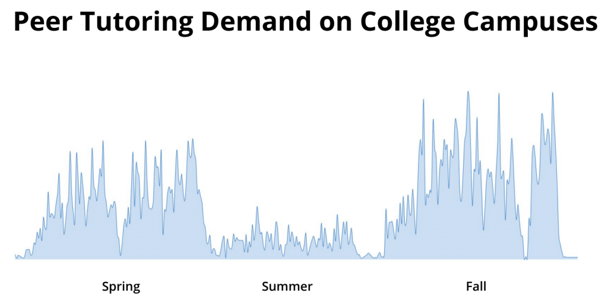What is “Induced Demand”? The phenomenon that after supply increases, more of a service is consumed. Why does this happen? Because there is latent demand – demand that can’t be satisfied by current supply.
You’ve seen it before… Companies like Uber, Airbnb, and Postmates utilize a sharing economy model to increase supply, decrease price, and induce demand.

The same principle applies to the supply and demand of tutors on campus. When the supply of tutors available on campus increases, so does the demand of students seeking tutors.
Why does this matter? Having more students participate in tutoring sessions on campus fosters a strong peer learning environment, which results in high levels of academic success.
Increased Accessibility = Increased Achievement
Increasing the amount of tutors available on campus will guarantee increased academic achievement on campus. Chances are, if students are struggling to find tutors, they will become discouraged and stop seeking the help they need. In fact, high-risk students are even less likely than others to use tutoring services. This can be avoided by increasing accessibility and ensuring the availability of more tutors on campus.

The Fluctuating Demand Problem
Is the supply of tutoring on your campus responsive to its fluctuating demand? Throughout the semester, there are times when more students are demanding tutoring. It is important to ensure that enough tutors are available to meet the needs of these students. However, there are also times where very few students are actively seeking help from a tutor. This means that tutors getting paid hourly at an academic center, may not be fully occupied.
As such, it is more cost-effective to ensure tutors are getting paid only for the work they are required to do. Employed tutors get paid to be a tutor; independent contracted tutors get paid when they tutor.
We see this with companies like Uber and Postmates, who understand how to satisfy fluctuations in demand with flexible supply (drivers are notified during times of high demand). This business model is successful because the workers only get paid when they are working so there is no money being spent where it isn’t needed.
Increasing Supply “Standardizes” Peer Tutoring
Every student on campus can benefit from peer tutoring. However, students are often hesitant to utilize tutoring due to outdated perceptions of what it is and who should use it. Increasing the supply of tutors on campus and making it easier for students to seek help on their own schedule, helps to eliminate the stigma and make tutoring the standard on campus.
At Harvard, peer tutoring is highly encouraged and supported. Harvard ensures the academic needs of their students are being met by constantly working to increase the number of tutors available. As a result, over 10% of undergraduate students at Harvard are peer tutors and more than 20% of students are actively participating in peer tutoring sessions.
Do you have the same opportunity?
It is important to ensure an adequate number of peer tutors on campus in order to maximize academic success and ensure your students are receiving the help they deserve. Are you maximizing the supply of tutors on campus? How many tutors do you employ vs. number of students at your school who could be a tutor?
What is stopping you from doing it? Constraints?


